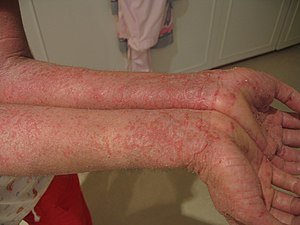Atopy
| Atopy | |
|---|---|
| Synonyms | atopic syndrome |
 |
|
| Eczema—a typical popatopic manifestation | |
| Pronunciation | /ˈætəpiː/ |
| Classification and external resources | |
| ICD-9-CM | 691.8 |
| OMIM | 147050 |
| DiseasesDB | 34489 |
Atopy is a predisposition toward developing certain allergic hypersensitivity reactions.
Atopy may have a hereditary component, although contact with the allergen or irritant must occur before the hypersensitivity reaction can develop.
The term atopy was coined by Coca and Cooke in 1923. Many physicians and scientists use the term "atopy" for any IgE-mediated reaction (even those that are appropriate and proportional to the antigen), but many pediatricians reserve the word "atopy" for a genetically mediated predisposition to an excessive IgE reaction. The terms if from Greek ἀτοπία meaning "placelessness".
Atopy (atopic syndrome) is a syndrome characterized by a tendency to be “hyperallergic”. A person with atopy typically presents with one or more of the following: eczema (atopic dermatitis), allergic rhinitis (hay fever), or allergic asthma. Some patients with atopy display what is referred to as the “allergic triad” of symptoms, i.e. all three of the aforementioned conditions. Patients with atopy also have a tendency to have food allergies, allergic conjunctivitis, and other symptoms characterized by their hyperallergic state. For example, eosinophilic esophagitis is found to be associated with atopic allergies.
Atopic syndrome can be fatal for those who experience serious allergic reactions, such as anaphylaxis, brought on by reactions to food or environment.
The individual components of atopy are all caused at least in part by allergy (type I hypersensitivity reactions). Therefore, atopic responses appear after the body is exposed to various allergens, for example pollen, dander, dust mites, certain foods, or chemical/physical irritants.
Although atopy has various definitions, in general, it is defined by the presence of elevated levels of total and allergen-specific IgE in the serum, leading to positive skin-prick tests to common allergens.
...
Wikipedia
